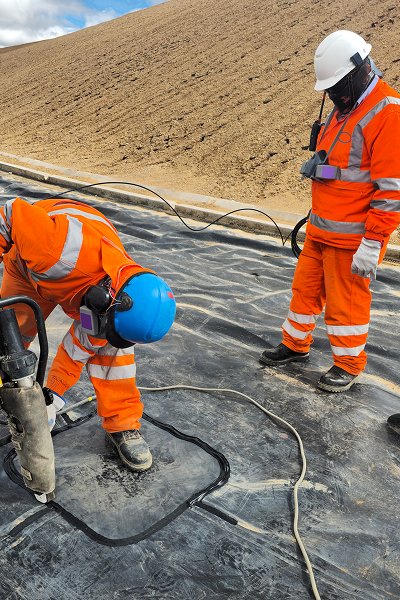What is a Biaxial Geogrid ?
Biaxial geogrid is a grid structure material with high tensile strength in both the vertical and horizontal directions, and is often used to enhance the bearing capacity of the roadbed and the integrity of the soil structure.
It is also made of polypropylene (PP) or polyethylene (PE), but uses an extrusion-punching-biaxial stretching process to ensure that it is evenly stressed in the X-axis and Y-axis directions.

What is uniaxial geogrid ?
Uniaxial geogrid is a geosynthetic material with extremely high tensile strength mainly in the longitudinal direction (single direction). Its structural characteristics are continuous polymer chains and tensile nodes along one direction, which can effectively disperse the load in the tensile direction.
Uniaxial geogrid is made of high-density polyethylene (HDPE) or polypropylene (PP) as the main raw material, and is made by extrusion-punching-unidirectional stretching process, which makes the grid have good rigidity and directional strength.

Key Differences Between Biaxial and Uniaxial Geogrids
| Comparison Aspect | Uniaxial Geogrid | Biaxial Geogrid |
|---|---|---|
| Tensile Direction | Extremely high tensile strength in one direction | Balanced tensile strength in both directions |
| Typical Applications | Retaining walls, embankments, steep slopes | Road foundations, railbeds, platforms, soft soil stabilization |
| Manufacturing Process | Extrusion → Punching → Uniaxial stretching | Extrusion → Punching → Biaxial stretching |
| Installation Precision | Requires precise alignment with the tensile direction | Flexible installation with no directional bias |
| Cost Efficiency | Higher unit cost due to targeted reinforcement | More economical for large-area use |
| Durability | Excellent in its direction, needs correct placement | Strong weather resistance, versatile durability |
| Load Distribution | Reinforces mainly in one axis | Distributes loads evenly in two axes |
| Rigidity | High stiffness along one direction | Good multidirectional stiffness |
Selection for different scenarios: biaxial vs uniaxial geogrids
Highway roadbed reinforcement
Recommended type: Biaxial geogrid
Reason: The roadbed is subjected to multi-directional loads (longitudinal + transverse) from the wheels, and requires high tension and stiffness in both the longitudinal and transverse directions to improve the overall load-bearing and stability.
Railway ballast structure
Recommended type: Biaxial geogrid
Reason: The railway ballast is subjected to vibration and heavy pressure for a long time. The biaxial grid can effectively disperse the stress, inhibit the sinking of ballast and uneven settlement of sleepers, and extend the maintenance cycle.
Landfill anti-seepage cover
Recommended type: Biaxial geogrid
Reason: The cover needs to withstand the multi-directional pressure brought by the operation of construction equipment. The biaxial grid provides equal strength support to prevent the cover from sinking and the destruction of the geomembrane.




Retaining wall and reinforced soil structure
Recommended type: Uniaxial geogrid
Reason: The retaining wall is mainly subjected to horizontal stress behind it. The uniaxial grid has high tensile force in one direction, which can accurately withstand the soil pressure behind the wall and improve the overall stability.
Slope support and reinforcement
Recommended type: Uniaxial geogrid
Reason: Slope stability requires the grid to have high tensile properties in the slope direction to resist shear slip. Uniaxial materials have clear directions, convenient anchoring, and are suitable for layered paving on the slope.
High and steep slopes or rock and soil retaining wall reverse reinforcement
Recommended type: Uniaxial geogrid (high-strength type)
Reason: Rock and soil retaining walls and high slopes have extremely high requirements for longitudinal tensile strength. The use of high-strength uniaxial grids (such as polyester materials) can meet long-term creep and support requirements.




| Application Scenario | Recommended Geogrid | Notes |
|---|---|---|
| Roadways, Railways | Biaxial | Balanced load distribution, rutting resistance |
| Retaining Walls, Slopes | Uniaxial | Unidirectional tensile strength for earth pressure |
| Landfills, Foundation Support | Biaxial | Prevents settlement and geomembrane damage |
| Heavy-Duty Platforms, Airports | High-Strength Biaxial | Handles repeated heavy loads effectively |
| Green Slopes, Landscaping | Biaxial + Vegetation Net | Structural + ecological solution |
FAQ;
How do I know which type of geogrid should be used for a project?
Look at the main stress direction and usage function of the project:
Under unidirectional stress → Use uniaxial grid (such as retaining wall, slope).
Multi-directional load → Use biaxial grid (such as road, airport, loading platform).
Can uniaxial grid be used instead of biaxial grid?
Generally not recommended. Uniaxial grid has insufficient lateral support, cannot effectively control settlement or deformation, and is prone to failure under multi-directional load conditions.
Can biaxial geogrid be used for retaining wall?
Not recommended. Although biaxial grid has certain tensile properties, its longitudinal strength is not as good as that of specially designed uniaxial grid, which can easily cause structural instability.
Is there any difference between the two in construction and laying?
Uniaxial grid: Generally, the laying direction (consistent with the stress direction) must be clearly defined and anchored.
Biaxial grid: The laying direction can be freely selected, which is more flexible and suitable for rapid construction.
In soft foundations, can only one type of grid be used?
It depends on the situation. For simple treatment, biaxial grids can be used. If greater strength and stability are required, a "biaxial + uniaxial" layered combination is often used.
Which has a longer service life, biaxial or uniaxial grids?
The service life is related to the material, UV exposure, burial environment, etc., not only depending on the type. Generally, the service life of grids made of polyester or HDPE can reach more than 50 years.
Can they be used in permanent structures?
Yes, especially polyester and durable polymer grids, which can be used for long-term structures such as abutments, retaining walls, and dams after certification.
Does geogrid need to be used with other materials?
In many projects, geogrids are used in conjunction with geotextiles, crushed stone cushions, geomembranes, etc. to enhance comprehensive performance such as drainage, anti-seepage, and reinforcement.


